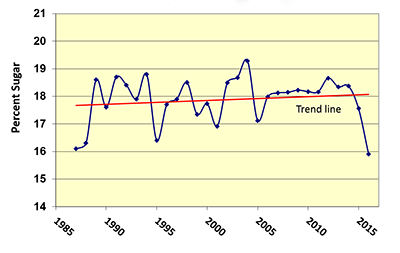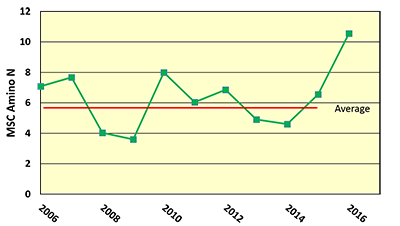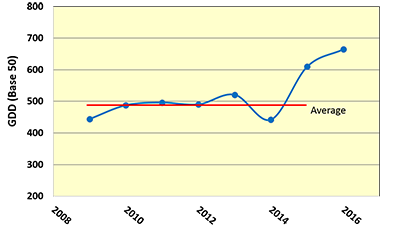What happened to sugarbeet quality in 2016?
Sugarbeet quality was reduced in 2016 because of Cercospora leaf spot, excess nitrogen and extended warm fall.

Michigan Sugarbeet growers experienced the lowest sugar content since 1986 (Figure 1). Multiple factors are involved when it comes to a sugarbeet plant producing and storing sugar. In fact, research has found that maximizing beet quality (percent sugar) and recoverable sugar per acre (RWSA) involves more than a dozen controllable factors.
To complicate matters, uncontrollable factors also cause beets to react to differing environmental situations each year. These will include the amount of rainfall, temperature, length of growing season along with disease inoculum level. The interaction of all of these factors will result in varying degrees of impact on yield and quality.

Figure 1. Michigan Sugar Company average grower sugar.
In 2016, Michigan was not alone. Other sugarbeet growing areas in the Midwest also experienced a significant slide in sugarbeet quality. In the Michigan Sugar official variety trials where leaf spot was well-controlled, sugar content was also lower than normal. The same is true in the Michigan State University Extension Sugarbeet Advancement variety trials this year. This is an indication that environment played a big factor along with leaf spot disease levels.
There is no doubt leaf spot issues in 2015 and again in 2016 played a large role in reduced quality. Many of our most popular varieties are fairly susceptible to Cercospora leaf spot. Going into the 2016 growing season, Cercospora inoculum levels were very high from the 2015 infestation. After the first week in August, rainfall occurred weekly, causing disease severity values (DSVs) on BEETcast weather stations to increase daily at a high rate for several weeks.
In addition to high levels of Cercospora, prolonged wet leaves are the perfect environment for other leaf diseases including Alternaria and bacterial leaf spot, which generally have not been significant in the past. Even though growers were aggressive in fungicide applications, leaf spot diseases were able to get a foothold, resulting in many fields being defoliated. Extensive research has found that early defoliation can significantly reduce tonnage and sugar content up to 2 percent.
Environmental conditions in the 2016 growing season were also not normal. Early-season droughty conditions coupled with a warm, extended fall also had a significant role in lower sugars. Sugar storage to the roots is stimulated in the plant as temperatures cool during fall. Extended periods with cold nights and sunny, cooler days provides the best conditions for sugar storage. The combination of cold temperatures coupled with nitrogen depletion in the soil also reduces the stimulus for plants to continue to grow.
The first half of the 2016 growing season had very dry conditions that reduced early growth and did not allow for the normal amount of nitrogen uptake. Additionally, growers have been increasing nitrogen rates over the past several years in response to higher yields, even though research has found higher rates may not be economically justified. Nitrogen not used early was then being carried over in the second half of the growing season when rainfall returned. This extra nitrogen availability, coupled with a very warm and extended fall, stimulated plant growth.
Sugarbeet plants with healthy foliage did not go light green this fall as is normally seen. This was reflected in harvest sugar samples that averaged 78 percent higher for amino nitrogen levels than normal for Michigan Sugar Company (Figure 2).Those plants that had burned down from leaf spot were also producing new foliage, which actually reduced sugar content.

Figure 2. Harvest quality samples average amino nitrogen. Note: Amino nitrogen was 78 percent higher than the average of 5.9 from 2006-2015.
Abnormal warm temperatures in September and October gave us 33 percent more growing degree-days than is normal for those months (Figure 3). The growing season extended well into November before we had the first killing frost.

Figure 3. Accumulated growing degree-days for September and October. Note: Growing degree-days (base 50) were 33 percent higher than the average of 499 from 2009-15.
As we look into the 2017 growing season, growers need to be aware of the increased risk for leaf spot. Disease inoculum levels will be extreme from high levels of Cercospora in the 2015-16 growing seasons. Given the right environmental conditions, this problem can repeat itself. The climate is changing, allowing for higher intensity storms, warmer conditions and extended growing seasons. Fungicide resistance has developed in strobilurin fungicides and is increasing in the other chemistries. Until new leaf spot-tolerant varieties enter the market, the majority of the highest yield potential varieties are fairly susceptible to leaf spot disease.
There certainly are other factors that can play a role in lower sugar that are not being discussed in this article. In 2017, growers will need to be vigilant against leaf spot by tightening spray schedules and always tank-mixing different chemistries. Applying fungicides later in the season is justified when an extended fall occurs. Utilize more leaf spot-tolerant varieties if they are a good fit for selected fields. Growers should also re-examine their nitrogen rates to make sure they are not unnecessarily high. With sugar prices relatively low and nitrogen cost fairly high, economics will change the most cost-effective rates.



 Print
Print Email
Email


